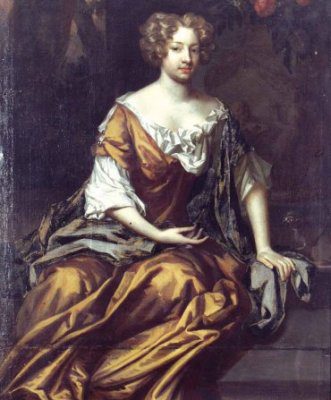Charlotte Sophie of Aldenburg
Charlotte Sophie, Countess of Bentinck, born Countess of Aldenburg (* August 5, 1715 in Varel, † February 4, 1800 in Hamburg), was, inter alia, a friend of Voltaire, Frederick the Great and Count Wilhelm von Schaumburg -Lippe.
Life
Her great-grandfather was Count Anton Günther von Oldenburg ( he saved his country during the Thirty Years' War against destruction ), his son Anton, who came from an illegitimate relationship with a nobility and the hereditary dignity of imperial princes Aldenburg ( oldest form of the name of Oldenburg ) endowed. The granddaughter of this first Anton is Charlotte Sophie, who grew up in Varel castle.
At the age of 15 years, Charlotte learns Sophie Albrecht Wolfgang ( 1699-1748 ), the reigning sovereign of his friend, the small state of Schaumburg-Lippe, and falls in love with him.
However, Charlotte Sophie's father Anton II ran into financial difficulties. Alden Castle, a tiny country among the German states, which includes the Office Varel, the glory Kniphausen and the Bailiwick of jade in the extreme, repeatedly devastated by storm surges north-west of the German Empire is not quite viable. Anton II borrows from the Dutchman Willem Bentinck, Lord of Oegstgeest and Pendrecht, 300,000 guilders. This creditor chooses Anton ultimately became the husband of his daughter Sophie Charlotte. The marriage will take place in 1733. A purpose and interest marriage that goes against Charlotte Sophie. Charlotte Sophie, Countess Bentinck now, moved to The Hague, is the mother of two sons, but still depends on the (now re-married his second wife ) Albrecht Wolfgang. When her father dies, she travels to Varel and does not return to her husband to The Hague.
She now lives rather as a kind of favorite in a curious three-way relationship with Albrecht Wolfgang am Bückeburger court: his wife, Charlotte, née Princess of Nassau- Siegen, widowed Princess of Anhalt- Köthen, namely, her childhood friend. Charlotte Sophie becomes pregnant by Albrecht Wolfgang. 1740 is divorced from Count Bentinck. In the same year begin Albrecht Wolfgang's sons George and William with their studies in the Dutch Leyden. Here they learn about the then already famous of all reconnaissance: Voltaire, who is involved in The Hague so that the " Anti- Machiavel ," first work of hopeful Crown Prince Frederick of Prussia to prepare for printing.
When Voltaire on the way back from Berlin visited in December 1740 for three days the court in Biickeburg, he learns next to Count Albrecht Wolfgang, the Countess Bentinck know and delight in the witty conversation with the two - of course in French. This encounter in the then beautifully appointed Castle Biickeburg is - according to the recent research of Voltaire researcher Frédéric Deloffre - the nucleus of Voltaire's novel Candide. In its view, the Countess Bentinck 's behind the " castle Tonder -ten- Tronkh " Biickeburg the castle, behind Cunegonde itself ( " red-cheeked, fresh, plump and appetizing ," said in chapter I, " the illustrious Westfalin " in Chapter XXII) behind the title character Candide, the author Voltaire himself and behind Candide's tutor " Pangloss " Johann Heinrich Meister, the educator of Count Albrecht Wolfgang's son William.
Your son brings Sophie Charlotte in Hanover to the world - in secret. Karl Donop later marshal of Saxony- Meiningen.
1748 Wolfgang Albrecht dies. His son William succeeds and begins to redevelop the nearly bankrupt country. Charlotte Sophie is now forced to leave the court in Biickeburg. Your highly indebted possession Varel Kniphausen is provided by the divorced husband, now to influence arrived in the States-General Count Bentinck, in receivership. When ordering the domestic heritage it falls into the hands of the portrait, Albrecht Wolfgang " in happier times wrote about it ": " Portrait of a wicked girl ," has listed her mother out. " Your mind is like a diamond, with one half bad ground, the other still in the raw state; but with the right touches this stone had all his fellows into the shade, " Albrecht Wolfgang writes to it.
The Countess Bentinck is leaving for a new life. She goes to Berlin, where she lives near King Frederick II. Voltaire, who also resides at the court of Frederick 1750 to 1753, she is a confidante. Contact them has continued with the Count Wilhelm of Schaumburg -Lippe, who often visited the Prussian metropolis. 1754 they must refrain with her ex-husband finally on the paternal heritage for the benefit of their two legitimate sons after the end of legal disputes. 1757-1761 she lived in Vienna, 1758, she traveled to Venice, through Italy, Switzerland and finally to Les Délices, the country house of Voltaire at Geneva (in this year he produced his novel Candide ). After a few years in Jever she pulls 1768 final to Hamburg, where she in her apartment on Jungfernstieg and the summer residence in Eimsbuettel maintains a much visited salon until her death.
Charlotte Sophie Bentinck and Countess Aldenburg is buried in the family vault in the Castle Church in Varel.
Patronage
Works and Letters
- Une femme des lumières. Écrits et lettres de la comtesse de Bentinck 1715-1800. Text presentes par Anne Soprani et André Magnan. Paris: Editions CNRS 1997 ( De l' Allemagne ) ISBN 2-271-05055-3.
- Voltaire et sa " grande amie". Correspondance complète de Voltaire et Mme de Bentinck ( 1740-1778 ). Ed. Frédéric de Deloffre et Jacques Cormier. Oxford: Voltaire Foundation, 2003 ISBN 0-7294-0815-9.








